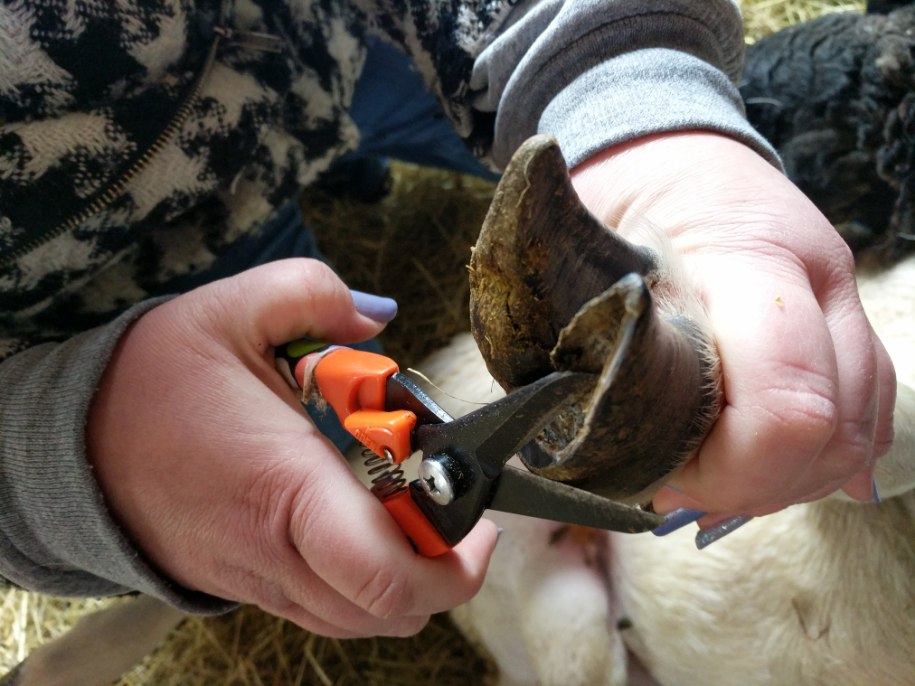Main Content

Proper hoof care is essential for healthy sheep. Hooves are literally the foundation on which your sheep stands. Preventative care and maintenance can reduce costly and detrimental health issues in your flock. Hoof health problems lead to lameness, decreased weight gain, reduced milk production and reduced wool production. Lame animals spend more time lying down, and do not move efficiently while grazing. Properly trimmed hooves truly allow your animal to put its best foot forward!
When learning to trim hooves, its best to start slowly and to have an experienced person to assist. Rather than flipping your sheep, you may find it easier to learn to trim hooves while the sheep is on a fitting stand or being held by another person. An unusual, but surprisingly effective way to practice is to start with hooves from a butcher shop. This way, you can practice on a stationary hoof, without worrying about injuring a live animal.
Plan on trimming hooves at least twice a year, but bear in mind that sheep on softer ground will need additional maintenance. Hoof trimming can be combined with shearing in order to reduce stress on the sheep.
When trimming hooves, the goal is to create a smooth, flat, level surface. Pockets or gaps are ideal environments for bacterial growth, which lead to infections. Look at the hoof of a newborn lamb to gain a good idea of ideal hoof shape.
Basic Hoof Anatomy:
- Hoof Wall – the outer layer of the hoof. A hard, protective structure.
- White Line – the middle layer of the hoof. This layer is softer and holds together the hoof wall and the inner sole.
- Sole – the inner area of the hoof, directly above softer tissues inside the hoof.
- Toe – the digit of the hoof, usually referring to the narrow tip of the hoof.
- Heel – the broad portion of the hoof.
General Reminders:
- You can always trim more off, but you cannot un-cut the hoof if you remove too much! Start with small cuts.
- Keep the hoof trimmers level to prevent cutting too deep.
- Complete each cut. Incomplete cuts in the hoof wall can be infiltrated by opportunistic bacteria.
- Hoof trimmers are extremely sharp!
- Keep the trimmers locked when not in use.
- Do not put trimmers in your pocket, or leave them on the ground where they could be stepped on.
- Carry hoof trimmers like a pair of scissors – with the tips pointed down.
- A small tool caddy is a great way to keep hoof care tools organized and easily accessible.
- As always, use the right tool for the job. Do not use dull or rusty hoof trimmers.
- Some shepherds prefer to use knives or other tools to trim hooves, however, it is safer and easier for 4-H youth to use trimmers.
- Clean hoof trimmers between use to minimize risk of transferring infectious bacteria. If you suspect a hoof health issue, trim that hoof last.
- Avoid trimming hooves during high stress times – extremely hot days, during late gestation, etc.
- As with anything, regular maintenance makes hoof trimming easier and reduces the risk of hoof problems.
How to Trim Hooves:
- Proceed with caution while trimming. If you notice any pink coloration, do not trim any further. Remember, inside the hoof, there is soft tissue and blood flow!
- Keep blood-stop powder on hand in case of injuries.
- Clean manure and mud from the hoof in order to see the hoof clearly.
- Use a stiff-bristled hoof brush. Do not use the tip of the hoof trimmers as a pick! This can damage the hoof wall.
- Large, compacted chunks of manure can be removed using a hoof pick.
- Work on one toe at a time.
- Start at the heel and work towards the tip of the toe and trim along the outer edge of the hoof wall first.
- Removing this growth first reveals the rest of the hoof, so you can see what else needs trimming.
- The toe should come to a rounded point.
- In severely overgrown hooves, the outer wall may completely cover the bottom of the hoof. This creates a pocket between the bottom of the hoof and the hoof wall, where manure and mud build up and create a perfect environment for anaerobic microbes that cause infections.
- If needed, trim the hoof wall between the toes. Generally, this area of the hoof wall is less overgrown than the outer wall.
- Check the skin between the toes (interdigital space) for signs of irritation or infection as many hoof issues start here.
- You may opt to apply a hoof treatment containing copper sulfate or zinc sulfate as a preventative measure.
- Trim across the heel. Again, the goal is to have a smooth, flat surface.
- If necessary, cut away overgrowth on the dew claws.
- Repeat on the next toe, and for each hoof.
Proper hoof care is essential for healthy, productive animals. Routine maintenance eliminates the stress and cost of treating hoof problems later.
By Mary McLaughlin, Somerset County 4-H Volunteer